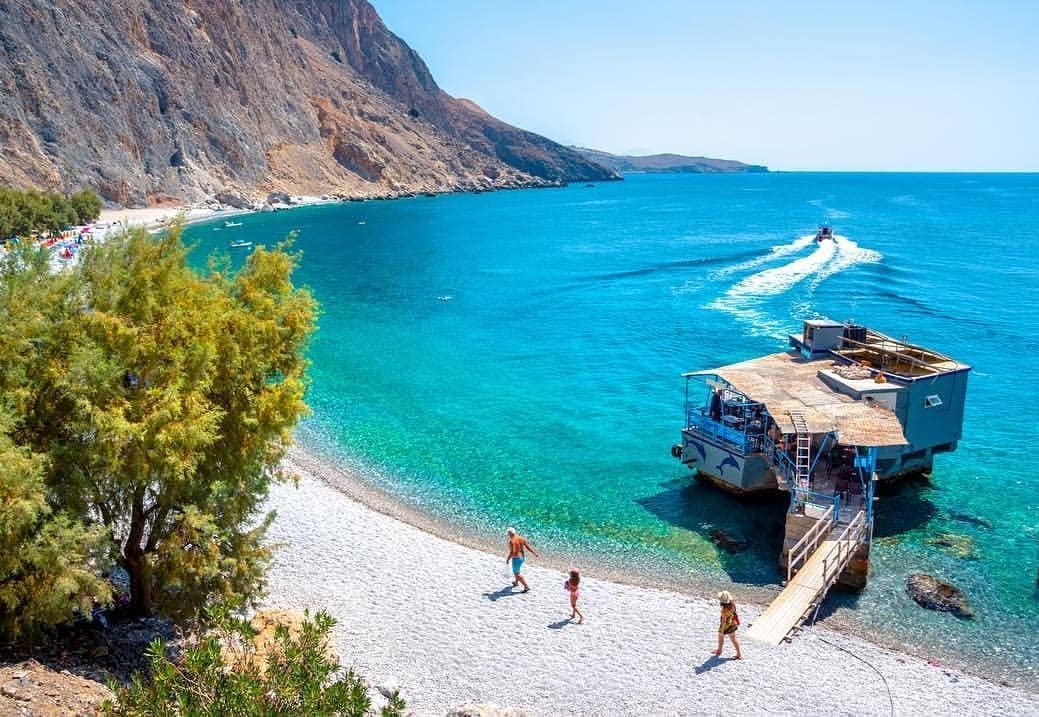For those of us who return to Crete year after year, the island’s beaches are like old friends, each with its own character and charm. While Elafonissi’s pink sands are world-famous and grace countless Instagram feeds, Crete’s coastline is dotted with hidden gems that even seasoned visitors might have overlooked. If you think you’ve seen it all, think again!
From wild, untouched stretches where ancient cedars meet the sea to tranquil coves with their own freshwater springs, these seven beaches might just surpass Elafonissi in beauty and atmosphere. Some require a bit of adventure to reach, whether it’s a scenic hike through dramatic gorges or a bumpy 4×4 ride through rugged terrain, but that’s exactly what keeps them so wonderfully unspoiled. Ready to discover your new favorite spot? Let’s explore these incredible beaches in Crete that locals have been keeping to themselves.
1. Kedrodasos Beach (Chania Region, West Crete)
Just a 10-minute drive and short hike from Elafonissi’s famous pink sands, Kedrodasos Beach feels like stepping into a fairy-tale landscape. Ancient juniper trees (often mistaken for cedars) create natural shade over pristine white sand, while crystal-clear turquoise waters stretch toward dramatic mountain backdrops.
What makes it special: This is Crete’s answer to Hawaii, completely wild and untouched. The 15-minute walk from the parking area through rocky terrain keeps the crowds away, leaving you with one of the island’s most peaceful spots. Dense juniper trees provide plenty of natural shade and privacy, making umbrellas unnecessary.
Know before you go: Kedrodasos is completely unorganized; no sunbeds, tavernas, or facilities of any kind. Pack everything you need, especially water and snacks. The beach welcomes everyone from families to naturists, creating a relaxed, tolerant atmosphere. Free camping under the trees is common, but the beach never feels crowded.
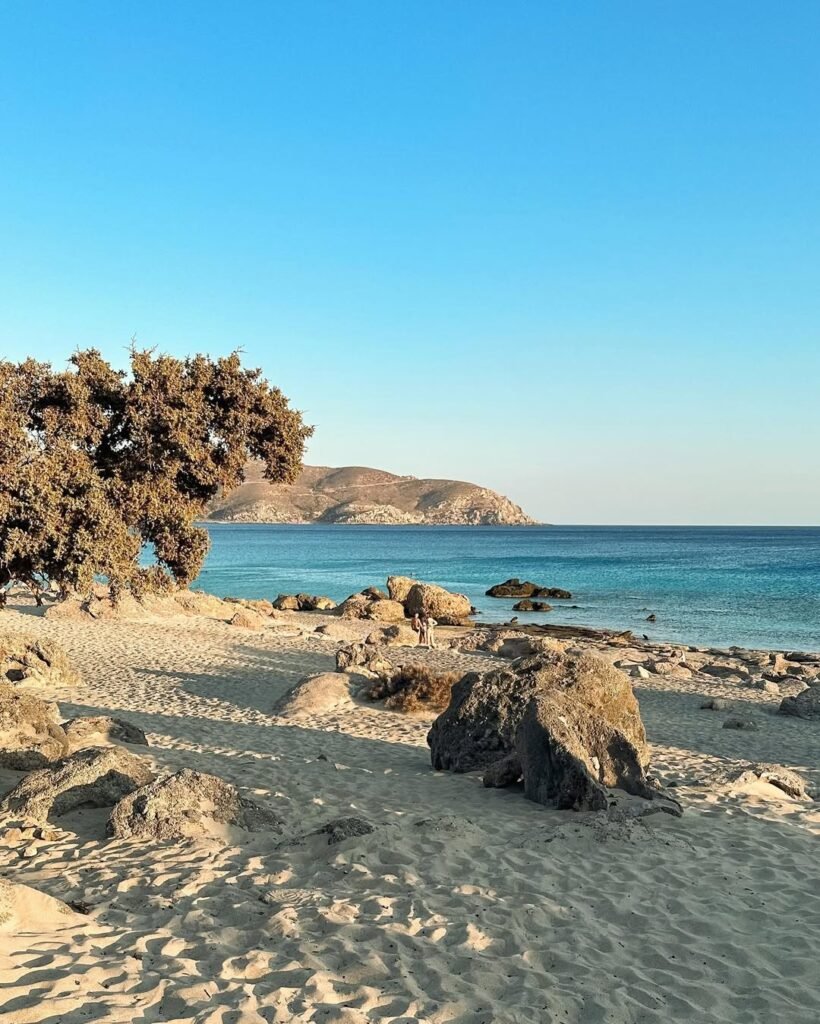
Best conditions: Visit on calmer days when winds are light. While the waters are perfect for snorkeling and swimming, strong winds can make conditions challenging for small children. The beach stays sheltered from the harsh winds that often affect neighboring Elafonissi, making it ideal for a peaceful day by the sea.
2. Glyka Nera (Sweet Water Beach) (Chania Region, South Coast)
Beneath towering 500-meter cliffs that create a natural amphitheater, Glyka Nera offers something truly magical: freshwater springs bubbling up through the pebbles. The name means “Sweet Water,” and you can actually drink the spring water right from the beach. This European top-20 beach (according to The Times of London) combines dramatic scenery with crystal-clear waters that offer visibility exceeding 100 meters.
What makes it special: The constant flow of spring water keeps the sea noticeably cooler than other Cretan beaches, even in midsummer. Snorkeling here is exceptional, and you might spot rare birds and marine life in this protected natural area. Tamarisk trees provide natural shade, while a quirky taverna perched on a rock serves refreshments when it’s open.
Know before you go: Access is part of the adventure. You can reach Glyka Nera by boat from Chora Sfakion or Loutro, or tackle the challenging coastal hiking trails (good physical condition and sturdy shoes required). The beach has two areas: one family-friendly near the taverna, another more secluded for naturists. Camping is allowed, but always check current regulations.
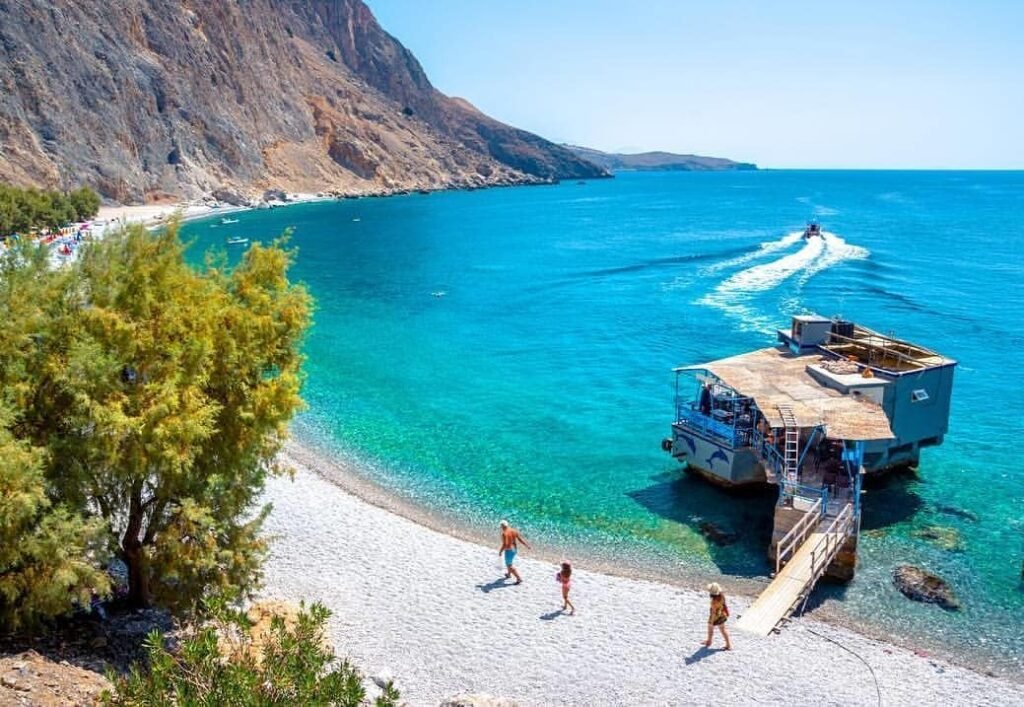
Best conditions: The freshwater springs can attract insects in warmer months, so bring repellent. Pack your own food and water since the seasonal taverna isn’t always open. Early morning and late afternoon offer the best light for photography enthusiasts wanting to capture those dramatic cliff formations.
3. Agiofarago Beach (Heraklion Region, South Crete)
Step into history at this sacred beach where around 300 Christian hermits once called the towering cliffs home. Agiofarago means “Gorge of the Saints,” and reaching this secluded pebble beach requires a scenic 20-30 minute hike through the dramatic gorge, passing the 14th-century chapel of Agios Antonios along the way. The reward? Crystal-clear waters, complete solitude, and a striking natural rock arch perfect for adventurous swimmers.
What makes it special: This isn’t just a beach trip; it’s a spiritual and historical journey. The deep, clear waters are ideal for snorkeling among underwater rock formations, while rock climbers tackle routes on the surrounding cliffs. You might spot rare bearded vultures overhead or encounter friendly goats during your hike. The hidden saltwater lake called Vourvoulitis adds an extra adventure for experienced hikers willing to tackle the steep descent.
Know before you go: The rough dirt road to the trailhead can challenge standard cars, especially after rain. Pack everything you need since there are no beach facilities, and bring water shoes for the hot pebbles. A small cantina near the parking area offers last-minute supplies. Unlike some remote beaches, naturism is discouraged here due to the religious significance, making it family-friendly.
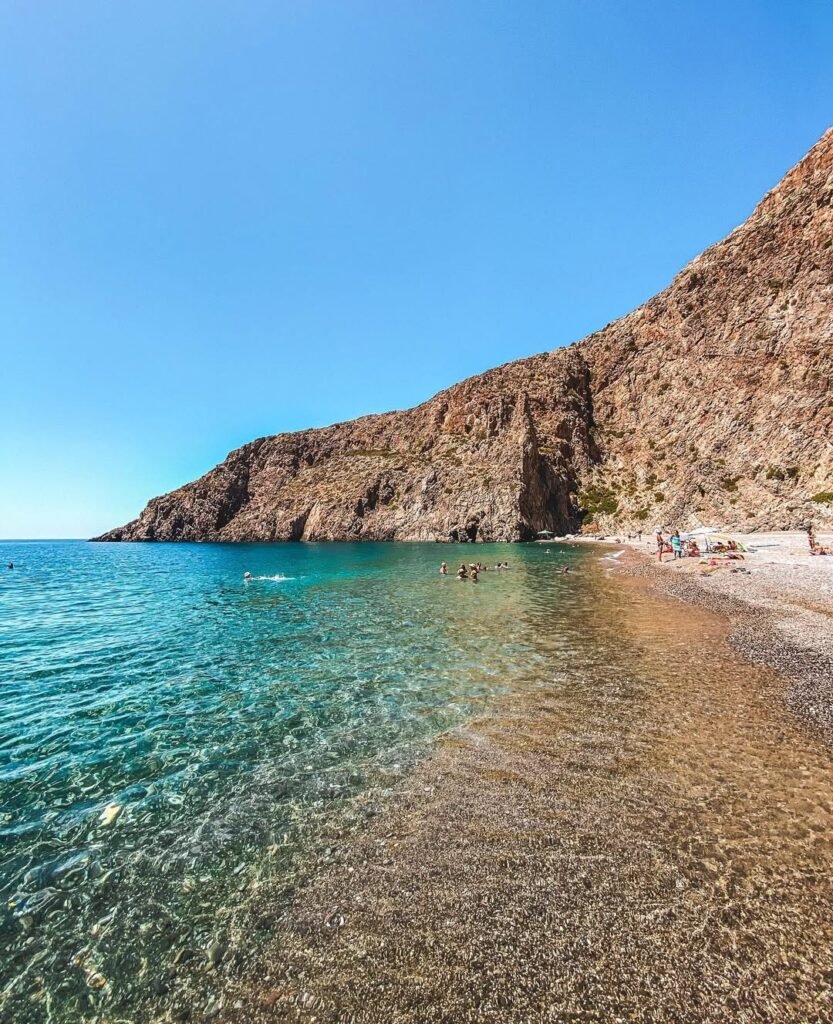
Best conditions: Visit early morning to avoid intense sun and crowds. The gorge offers little natural shade, so sun protection is crucial. While some visitors sunbathe nude at the far end, discretion and respect for local customs are important. Watch for falling debris if rock climbers are active on the cliffs above.
4. Red Beach (Kokkini Ammos) (Heraklion Region, South Crete)
Picture crimson sands meeting turquoise waters against dramatic cliff backdrops, and you’ll understand why Red Beach captures hearts worldwide. This 300-meter stretch of striking red sand sits in a protected Natura 2000 zone near Matala, carrying echoes of its 1960s hippie heyday. The sand’s color shifts from deep red to ochre throughout the day, creating an almost otherworldly landscape that photographers absolutely love.
What makes it special: Red Beach ranks among CNN’s top 25 nudist beaches globally, maintaining that relaxed, bohemian vibe that attracted free spirits decades ago. Look for unique rock carvings inspired by Minoan and Egyptian figures created by Belgian artist Gerard at the northern end. You might even spot endangered Mediterranean seals in nearby sea caves or Cretan mountain goats (kri-kri) scaling the cliffs above.
Know before you go: The 30-45 minute hike from Matala over Kastri hill is more challenging than expected, with rocky, uneven terrain and steep sections (sturdy shoes essential). Alternatively, take a 5-euro boat ride from Matala harbor. There’s virtually no natural shade and limited umbrella rentals, so bring sun protection. You’ll find a small stone coffee shop and the “legendary” mojito bar on site, though they tend to be on the pricier side.
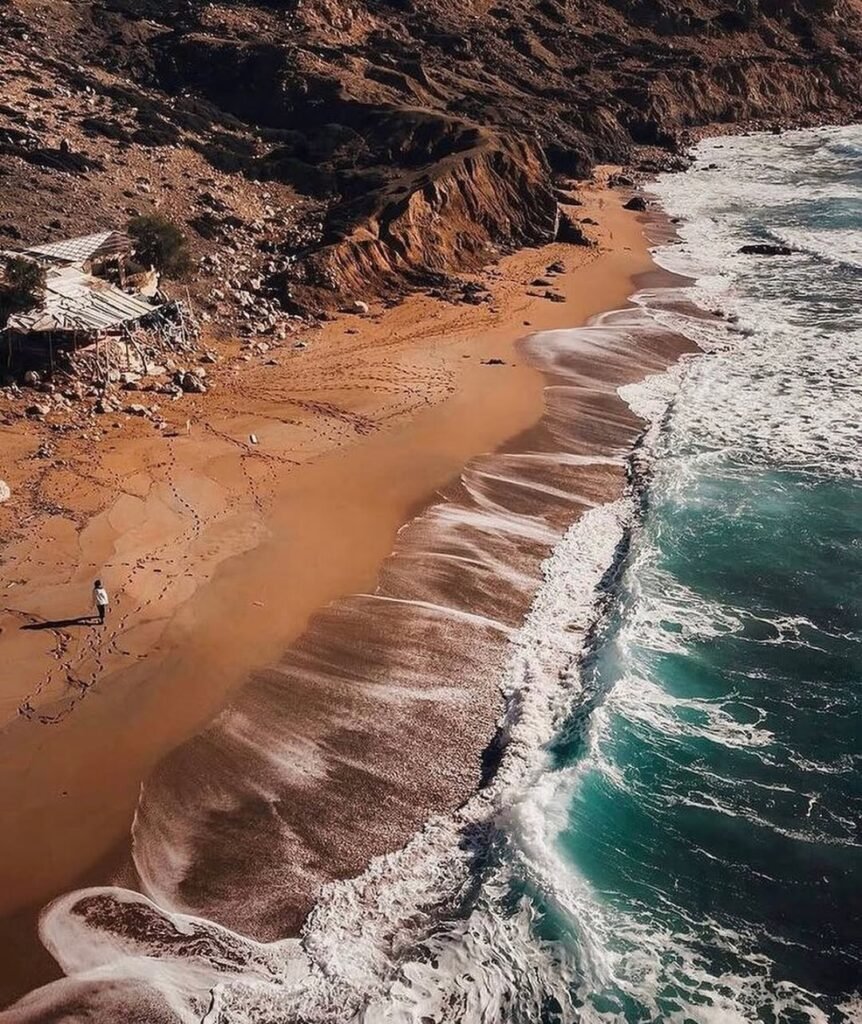
Best conditions: Visit at sunrise or sunset for the most vivid sand colors and dramatic lighting. The beach faces west, making it exposed to afternoon winds that can create strong waves. I always like to think of leaving a place even better than you found it if you can, so please help preserve this special place by packing out all trash and being mindful when taking photos around naturist areas.
5. Xerokampos Beach (Lassithi Region, East Crete)
Welcome to Crete’s most remote coastal paradise, where nearly 6 kilometers of diverse coastline awaits discovery. Located 103 km southeast of Agios Nikolaos, Xerokampos feels like a different planet with its arid mountains meeting turquoise waters. The journey here via the scenic Ziros Plateau is an adventure itself, winding through ghost-like medieval villages before revealing this spectacular stretch of golden sand, white sand, pebbles, and even natural clay beaches perfect for DIY spa treatments.
What makes it special: This isn’t just one beach but a collection of hidden coves and dramatic landscapes within a small area. The 630-meter main south beach offers crystal-clear, calm waters ideal for swimming and snorkeling, while nearby Vourlia Bay protects rare white sand lilies. You’ll find ancient Hellenistic ruins, a seasonal salt lake that becomes a salt flat in summer, and the charming blue-domed church of Saint Nicholas overlooking Ambelos beach.
Know before you go: Despite newly paved roads from Ziros and Zakros, this area remains blissfully undeveloped with just a handful of guesthouses, tavernas, and mini markets. Stock up on essentials like fuel and pharmacy needs in nearby Zakros before making the final approach. The nearby Lamnoni Gorge offers excellent hiking opportunities for those wanting to explore beyond the beaches.
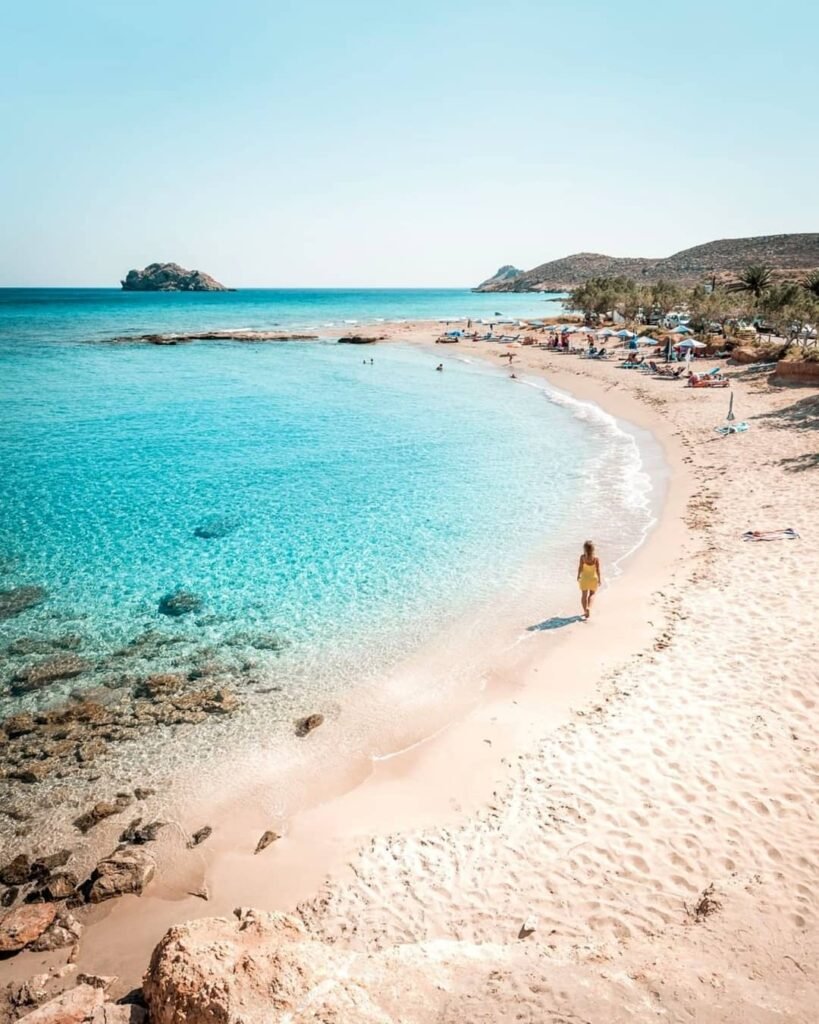
Best conditions: Shoulder seasons (May to June, September to October) offer the perfect balance of pleasant temperatures (20-30°C) and minimal crowds. While discrete camping happens, always respect local regulations and the fragile environment. The exceptionally clear water and diverse marine life make this a snorkeler’s dream, especially when conditions are calm and visibility is at its peak.
6. Voulisma Beach (Lassithi Region, North-East Crete)
Often called “Crete’s Caribbean,” Voulisma Beach combines postcard-perfect beauty with practical convenience just 12 km east of Agios Nikolaos. This Blue Flag certified stretch of powdery white sand and vivid turquoise waters sits nestled between lush green hills and olive groves, creating one of the most photographed spots on the island. Unlike Crete’s more remote gems, Voulisma proves that accessible can still mean spectacular.
What makes it special: The shallow, crystal-clear waters offer excellent visibility for snorkeling and underwater photography, while remaining perfectly safe for families with children. Sunset views here are absolutely stunning, with the beach getting sunlight late into the evening. For history lovers, the ancient Minoan town of Gournia and Panagia Faneromeni Monastery are just a short drive away, making this perfect for combining beach time with cultural exploration.
Know before you go: Voulisma gets extremely busy from 11 AM to 3 PM during peak season, so early morning or late afternoon visits offer a much more relaxed experience. You’ll find full amenities including sunbeds, umbrellas, showers, changing rooms, and a beach bar, though prices can be high. The quieter western end features large stones and offers more solitude, while nearby small bays like Hartalami Kolimbos provide peaceful alternatives.
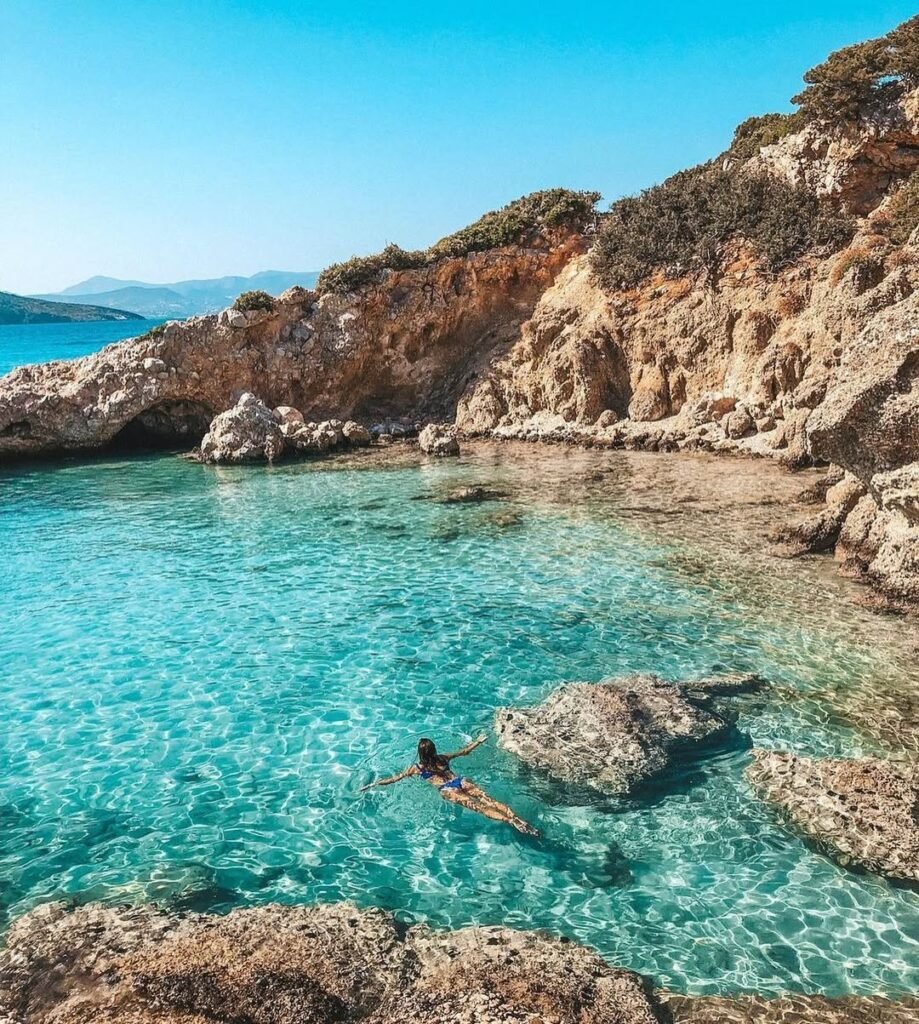
Best conditions: Water shoes are helpful for exploring the pebbly areas and smaller nearby beaches. Since natural shade is limited, sun protection is essential during hot days. The water stays clear and inviting even with waves, and you can easily combine your visit with hiking the nearby Richtis Gorge or exploring other beaches like Agios Panteleimon for a full day adventure.
7. Menies Beach (Chania Region, North-West Crete)
For the ultimate off-the-grid experience, Menies Beach sits on the remote Rodopou Peninsula where ancient history meets absolute tranquility. This pristine cove of smooth pebbles and marble stones requires a committed 17-23 km dirt road journey or boat trip from Platanias, but rewards adventurers with crystal-clear waters and the ruins of the Diktynna sanctuary dedicated to Cretan goddess Vritomartis just steps away.
What makes it special: You’ll often have this Natura 2000 protected paradise completely to yourself, with only wild goats for company and the sounds of waves and seabirds breaking the silence. The calm, deep blue waters stay inviting even when other beaches are windy, making it perfect for swimming, snorkeling, and cliff diving from the 2-3 meter rocks. Lucky visitors might spot dolphins offshore, while the nearby abandoned 9th-century monastery of St. George offers additional exploration opportunities.
Know before you go: This is serious adventure territory. The isolated dirt road has no cell phone signal for much of the drive, so a 4×4 vehicle is strongly recommended over standard rental cars. There are absolutely no facilities, fresh water, or amenities, so pack everything you need and let someone know your plans. Check your fuel and tire condition before departing, and consider the popular boat trips from Kolymbari or Platanias as an alternative.
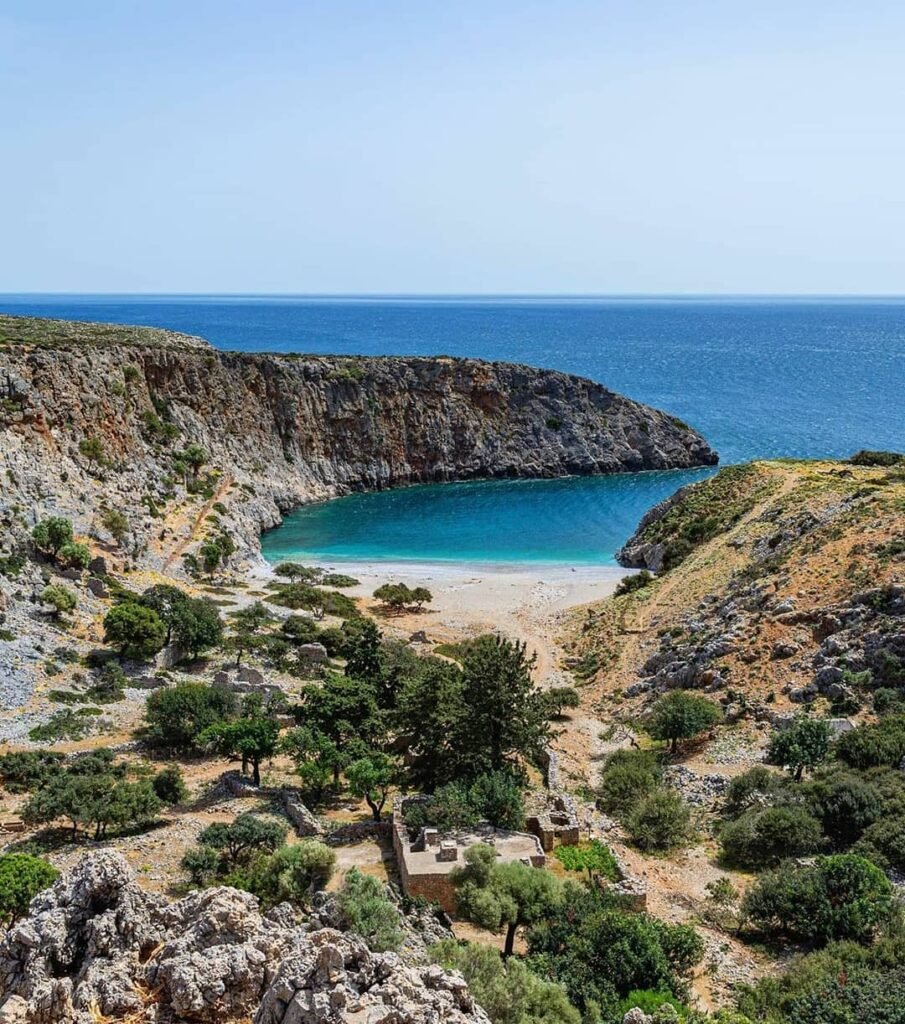
Best conditions: Water shoes help with the smooth pebble beach, though they’re quite comfortable to walk on. The sunsets here are spectacular, painting the sky in vivid colors as the sun dips behind the peninsula. While rarely crowded even in high season, there are no lifeguards, so exercise caution especially with children. Remember to respect the archaeological site and never remove artifacts, even pottery shards you might discover.
Conclusion
Crete’s 1,000+ kilometers of coastline harbor secrets that even locals are still discovering among its 300+ beaches. While Elafonissi draws the crowds with its famous pink sands, these seven alternatives prove that the island’s most magical moments often happen in the spaces between the guidebook highlights. From ancient hermit caves to natural clay spas, from freshwater springs to goddess sanctuaries, each hidden cove carries its own legend and offers rewards that no Instagram post can truly capture.
The beauty of exploring Crete’s lesser-known shores isn’t just in finding pristine waters or perfect solitude (though you’ll find plenty of both). It’s in understanding that after thousands of years of human history, this remarkable island still holds surprises for those willing to venture beyond the obvious. Whether you’re seeking the thrill of a challenging 4×4 adventure or the simple pleasure of an uncrowded swim, Crete’s hidden beaches remind us that the best travel experiences aren’t always the most famous ones. Sometimes they’re the ones where endangered monk seals might surface nearby, or where you’ll stumble upon pottery shards from civilizations that thrived here millennia ago, connecting you to the timeless magic that makes Crete eternally captivating.
Further reading:
27 Tips & Hilarious Truths About Driving in Crete
19 Traditional Cretan Tavernas in Chania Region That You Must Try

